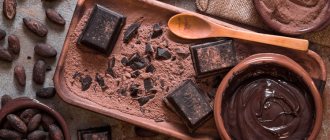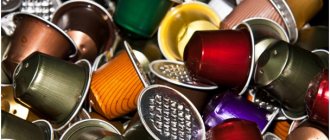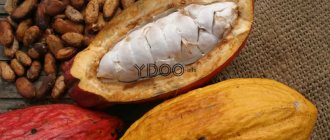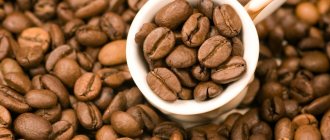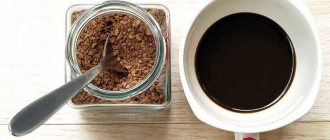How much caffeine is in instant coffee?
Most people drink instant coffee, which, unlike natural ground coffee, can be decaffeinated or have a low concentration of the substance. Many people have a question: is there caffeine in instant coffee products, and if so, what is the proportion of the alkaloid in a teaspoon of instant coffee? Despite the fact that such a drink is considered worse than natural, almost every family has a jar of the product for instant preparation. The reason lies not only in advertising, but also in habit and convenience.
Instant coffee is available in several types:
- sublimated;
- in granules;
- in powder form.
Such products are produced using a special technology from Arabica or Robusta coffee beans that have not been selected for sale. To prepare instant coffee, the raw materials are initially roasted and ground. The resulting mass is treated with boiling water and undergoes several more production stages.
An instant drink always contains caffeine, even if the label denies this fact. The question then becomes, how much caffeine is in a cup? It is impossible to accurately determine such an indicator. On average, a standard-sized cup can contain between 50 and 100 mg. The concentration of the substance depends on the volume of water and the number of spoons of coffee raw materials. According to average data in 1 tsp. granular powder approximately 50 mg.
What determines the caffeine content?
The concentration of the alkaloid in instant coffee directly depends on the type of coffee beans that were used by the manufacturer to prepare this product. For example, the substance content in beans per 100 g of coffee beans:
- Arabica – 1000-1500 mg per 100 g;
- robusta – from 1100 to 2500 mg per 100 g;
- Liberica – from 700 to 2500 mg per 100 g.
Review of some brands
In most cases, freeze-dried products are made from robusta beans. Despite the fact that the variety has a less pronounced taste and aroma, it is chosen due to its lower cost than Arabica beans. This variety is used because the drink has a good invigorating effect due to its higher percentage of caffeine. The concentration of the alkaloid also depends on the coffee manufacturer.
The most popular brands and the caffeine content in their products:
- Nescafe classic – 4.2%, which makes the drink quite strong.
- Black Card Gold – 4.2%.
- In Pele coffee the concentration is slightly lower, 3.8%.
- Jacobs Monarch is popular, but the percentage of alkaloid in this product is only 3.3%.
- The lowest content is in Chibo Exclusive and is 3.1%.
Coffee drinks labeled "decaffeinated" still contain small amounts of the alkaloid. According to standards, this figure should not exceed 0.3%. Not all manufacturing companies are conscientious about complying with standards, so the concentration of the substance may exceed the permissible limit.
In addition, it is worth considering that manufacturers often use low-cost technologies for component extraction. In this case, an incompletely washed solvent may affect the taste of the finished drink. Today, the market offers a large number of inexpensive products, the most popular of which are Nescafe, Le Cafe Mocca, Ambassador, Clipper, Matador.
Rating of some instant coffee brands based on caffeine content and other indicators
Caffeine is extracted not only to create a drink without it, but also for further use in the manufacture of medicines. This process can occur in different ways and consists of several steps:
- steam processing of coffee beans;
- extracting coffee extract with a specialized solution;
- repeating the previous procedure several times until the extract is completely extracted from the grain.
After all the procedures, the resulting product should retain the taste and smell of natural coffee before processing. The production of an instant product should not affect the content of beneficial microelements in the finished drink. Due to the fact that technological progress does not stand still, there are several options for properly producing a decaffeinated drink:
- CO₂ extraction;
- treatment with ethyl acetate or dichloromethane;
- obtaining an extract using boiling water and a carbon filter.
There are also natural decaffeinated coffee beans, such fruits grow in Brazil. But they are used only to create Decaffito brand products.
Manufacturing
Many people wonder if instant coffee contains caffeine. To create this product, coffee beans are roasted, crushed and treated with hot water. Then the resulting enriched drink is dried using different methods:
- Spray-dry or powder is made according to the “dispersion drying” scheme. The extract is sprayed in a stream of hot air. Eventually it dries and turns into powder.
- Freeze dry (sublimated) is produced using the “freeze drying” method. The frozen extract is dehydrated in a vacuum by sublimation. This process preserves the constituent substances of the product better, but it is more expensive due to the more energy-intensive technology compared to other types of instant coffee.
- A granular product is made from a powder that is spray-dried through aggregation, which is the process of moistening the powder to create granules.
At least one brand of instant vigor drink is known in the form of a concentrated liquid.
Comparison of ground and instant coffee
People ask whether there is more caffeine, natural or instant. In order to obtain ground coffee, roasted beans are taken. It is possible to grind raw materials at home using a manual or electric coffee grinder. Store-bought ground coffee may contain various additives, so it is better to purchase beans and grind them yourself. In these cases, a natural product without additives is obtained.
As for powder products, they contain only 15% coffee beans. The remaining components are various emulsifiers, stabilizers, flavors, dyes and other additives of chemical origin. To create such mixtures, the cheapest varieties of coffee are used.
Of the instant types of product, freeze-dried is considered the highest quality.
Nowadays, the vacuum freezing method is increasingly used, which makes it possible to obtain various types of soluble products. But in such coffee there are practically no useful microelements left due to the evaporation of water from the beans. Natural raw materials contain not only caffeine, but also more microelements useful for the human body.
Presence of caffeine
So does instant coffee have caffeine? Usually people have no doubt that this substance is present in coffee. They consider it an integral component of the drink. In fact, the alkaloid determines the well-known strength of the invigorating drink. It is odorless, but at high density it imparts a noticeable bitterness to the drink.
The amount of caffeine does not determine the specific taste or coffee aroma of the drink. Therefore, based only on taste sensations, it is impossible to say for sure whether instant coffee contains caffeine.
You can indirectly judge its presence by the invigorating effect of drinking a cup of drink. Caffeine has both negative and positive effects on the body. In addition, it has psychostimulating qualities. Therefore, manufacturers, along with simple instant coffee, produce its decaffeinated version.
Consumption standards
Today, everyone knows that the consumption of drinks that contain caffeine should be limited. The first reason is that the drug can cause addiction in humans. Second, for many diseases the use of an alkaloid is prohibited.
According to the conclusion made by Russian doctors during a special study, the norm for a healthy person is to consume caffeine in a dosage of 150 to 300 mg per day. This value can be divided into several cups or drunk at one time.
American scientists provide their statistics, where single use should not exceed 100 mg, and 3 doses per day are allowed. Freeze-dried coffee drink is not recommended to be consumed in unlimited quantities, despite the fact that it contains much less caffeine than natural coffee.
Methods for Extracting Caffeine from Beans
The need for such technologies arose not only because coffee had to be made less strong and safer for human health. Caffeine is a valuable raw material for the pharmaceutical industry , which means it was necessary to learn how to extract this ingredient.
The pioneer laurels in this matter belong to the German entrepreneur Ludwig Rosemus. In 1903, he had to rack his brains over how to save coffee, a large batch of which was transported by sea and was not saved from the water during a storm. Studying the degree of suitability of the product, Rosemus came to an unexpected conclusion: the taste characteristics of the product were practically not affected, but the caffeine was clearly much less than that contained in natural coffee that was not damaged by the storm.
Having made this discovery, Rosemus continued his research, and soon created and patented his own method for producing the alkaloid. After that, he established the production of a caffeine-free product in the United States, giving it the name “Sanka” (translated from French “sans coffeine” means “caffeine-free”).
Today, they have learned to extract caffeine in several ways, but each of them is based on what Ludwig Rosemus invented in his time, soaking. These are the methods:
- Swiss. It began to be used in 1979. The method is highly effective - 99.9% of caffeine can be extracted from beans; the method is environmentally friendly, but, unfortunately, expensive. The method is as follows: green coffee beans are kept in heated water, into which the alkaloids pass after some time. By passing water through charcoal filters, pure caffeine is obtained, and the liquid itself, which contains valuable oils, without which the drink risks becoming empty and tasteless, is returned to the original product and dried.
- Direct (or traditional) method. Its peculiarity is that the beans are first soaked in water and then in a special solvent, which speeds up the caffeine extraction process. This is followed by another treatment with water (boiling water) and drying. Ethyl acetate is used as a solvent in modern production, and previously preference was given to methylene chloride, but it turned out that this substance has a negative impact on the Earth’s ozone layer, so in 1995 restrictions were introduced on its use. However, neither one nor the other artificial solvent is ideal: it is not possible to completely wash them out of the grains, and this is the main disadvantage of the technological process.
- Indirect method. It is in many ways identical to the previous one, but consists of several processing cycles, thanks to which the beans retain their aroma and taste more fully.
- CO2 extraction. In this technology, water is present in a vapor state. After processing the grains with it, the raw material is transferred for 10 hours to a special chamber filled with carbon monoxide (CO2) under pressure. The gas releases caffeine from the beans while preserving valuable coffee oils. Another advantage of the method is that the final product is completely free of chemical impurities.
How to froth milk for cappuccino? The answer is in this article.
Read about the symptoms of coffee allergy in adults in this publication.
Caffeine - benefits and harms
Caffeine (found in coffee, other drinks, and even in tablet form) has a number of positive effects on the body. Since it stimulates the central nervous system, its use causes a surge of energy, increased concentration and improved performance.
In fact, caffeine can be considered a fat burner. Drinking a cup of coffee before training increases your heart rate and improves strength - which has a positive effect on the effectiveness of your training and the number of calories burned.
Contraindications and harm
Caffeine may harm the health of some people. First of all, it is dangerous for those who are characterized by increased irritability and anxiety. Large doses of coffee taken in a short period of time can provoke panic attacks.
In addition, caffeine is quite difficult to give up. If you are used to starting your morning every day with a cup of coffee, abruptly quitting the habit will negatively affect your well-being. Headache, lethargy, and problems sleeping may occur. However, such symptoms usually disappear within 3-4 days.
***
The caffeine content in a cup of coffee depends on both the amount of product used and the brewing method. However, instant coffee often contains more caffeine than natural coffee. Since the source of caffeine in it is uric acid and xanthine, therefore the effect of this caffeine is stronger.

